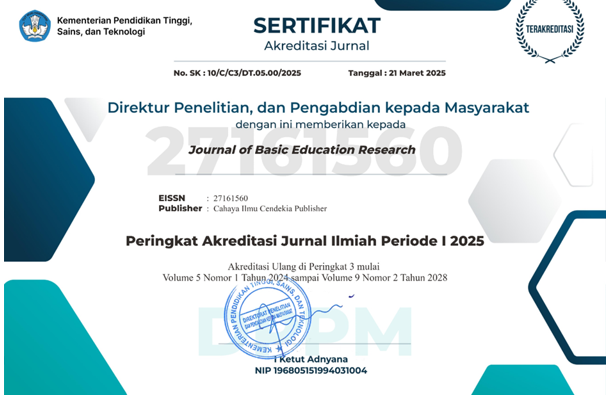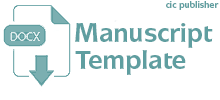A Touch of Culture in Learning: Teaching Materials My Food is Healthy and Nutritious for Elementary School
Abstract
Purpose of the study: This research aims to design teaching materials grounded in local wisdom and to evaluate the feasibility of these materials for the elementary/MI level, specifically focusing on Theme 9 "My Food is Healthy and Nutritious" and Subtheme 1 "My Food is Healthy and Nutritious."
Methodology: The research employed the Research and Development (R&D) method utilizing the ADDIE model. The participants included one class teacher and two lecturers who provided feedback through validation questionnaires and teacher response questionnaires.
Main Findings: The findings indicate that the responses from both lecturers regarding the development of teaching materials based on local wisdom were valid, with lecturer II's responses being highly valid. The teacher's feedback also confirmed the high validity of the teaching materials developed. Based on these results, it can be concluded that the designed teaching materials are suitable and effective for use in learning activities.
Novelty/Originality of this study: This research represents a significant advancement in the design of teaching materials by creatively integrating local wisdom to enhance the understanding of Class IV SD/MI students about health and nutrition through Theme 9 and Subtheme 1. Adopting an innovative design approach, this study pioneers a new direction in Class IV SD/MI learning, exploring effective strategies to incorporate local wisdom into teaching materials to strengthen students' comprehension of healthy and nutritious food.
References
L. Mishra, T. Gupta, and A. Shree, “Online teaching-learning in higher education during lockdown period of COVID-19 pandemic,” Int. J. Educ. Res. Open, vol. 1, no. June, p. 100012, 2020, doi: 10.1016/j.ijedro.2020.100012.
R. A. Salas-Rueda, G. De-La-cruz-martínez, C. Alvarado-Zamorano, and E. Prieto-Larios, “The Collaborative Wall: A Technological Means to Improving the Teaching-Learning Process about Physics,” Cent. Educ. Policy Stud. J., vol. 12, no. 4, pp. 205–231, 2022, doi: 10.26529/cepsj.1167.
N. Erlina, Prayekti, and I. Wicaksono, “Atomic Physics Teaching Materials in Blended Learning To Improve Self-Directed Learning Skills in Distance Education,” Turkish Online J. Distance Educ., vol. 23, no. 4, pp. 20–38, 2022, doi: 10.17718/tojde.1182747.
Ö. Altintas, “The use of open-ended items for giving feedback during the formative assessment process,” Int. J. Assess. Tools Educ., vol. 9, no. Special Issue, pp. 109–125, 2022, doi: 10.21449/ijate.1132981.
C. D. Cao, L. T. Phan, and T. T. Nguyen, “a Study on the Competency-Based Education of Lecturers in Universities of Technology and Education,” Int. J. Educ. Pract., vol. 10, no. 3, pp. 267–276, 2022, doi: 10.18488/61.v10i3.3117.
G. Oflaz, “Evaluation of Educational Games Prepared by Mathematics Teacher Candidates According to Game Design Key Model,” Educ. Policy Anal. Strateg. Res., vol. 18, no. 1, pp. 145–174, 2023, doi: 10.29329/epasr.2023.525.7.
R. Siddiqui and K. A. Soomro, “Teachers’ Perceptions regarding Moral Education in Private and Public Schools in Karachi: A Comparative Study,” J. Educ. Educ. Dev., vol. 9, no. 2, pp. 229–252, 2022, doi: 10.22555/joeed.v9i2.664.
R. Abidin., N. Suryani., and S. Sariyatun, “Students’ perceptions of 360 degree virtual tour-based historical learning about the cultural heritage area of the Kapitan and Al-Munawar villages in Palembang City,” International Journal of Social Sciences and Management, vol. 7, no. 3, pp. 105-112, 2020. doi: 10.3126/ijssm.v7i3.29764
A. Astalini., D. Darmaji., D. A. Kurniawan., D. Chen., R. Fitriani., M. Wulandari., S. Maryan., N. N. Simamora., and A. Ramadhanti, “A Study for Student Perception of Mathematical Physics E-Module Based on Gender,” Journal of Turkish Science Education, 19(3), 911-936, 2022.DOI: 10.36681/tused.2022.156
M. Maison., S. Syahrial., S. Syamsurizal., and T. Tanti,“Learning Environment, Students’ Beliefs, And Self-Regulation In Learning Physics: Structural Equation Modeling,”Journal of Baltic Science Education, vol. 18, no. 3, pp. 389-403. 2019. doi:10.33225/jbse/19.18.389
M. D. W. Ernawati, D. Muhammad, A. Asrial, and M. Muhaimin, “Development of Creative Thinking Skill Instruments for Chemistry Student Teachers in Indonesia”, Int. J. Onl. Eng., vol. 15, no. 14, pp. 21–30, 2019, doi: 10.3991/ijoe.v15i14.11354
Y. Yusnidar., M. D. W. Ernawati., D. A. Kurniawan., M. Z. Azzahra., F. I. Putri., and N. Prameswari, “Effect of learning using the problem-based learning (pbl) model with scaffolding on creative thinking and learning independence,” Journal of Southwest Jiaotong University, vol. 58, no. 5, 2023, doi: 10.35741/issn.0258-2724.58.5.52
A. Fadli and Irwanto, “The effect of local wisdom-based ELSII learning model on the problem solving and communication skills of pre-service islamic teachers,” Int. J. Instr., vol. 13, no. 1, pp. 731–746, 2020, doi: 10.29333/iji.2020.13147a.
N. Intem, T. Phuwanatwichit, A. Sarobol, and C. Wannapaisan, “The Local Wisdom Management Mohom for Stable Inherit and Lifelong Learning,” J. Educ. Learn., vol. 10, no. 5, p. 38, 2021, doi: 10.5539/jel.v10n5p38.
S. Bahri, M. Ramly, A. Gani, and S. Sukmawati, “Organizational Commitment and Civil Servants Performance: The Contribution of Intelligence, Local Wisdom and Organizational Culture,” Eur. J. Bus. Manag. Res., vol. 6, no. 1, pp. 128–134, 2021, doi: 10.24018/ejbmr.2021.6.1.720.
F. Marmani, “Creating Gender Equality in the Educational System Foteini,” Anatol. J. Educ., vol. 7, no. 1, pp. 57–72, 2021, doi: https://doi.org/10.29333/aje.2022.715a.
M. E. I. Khan, “Deploying Blended Learning in the New Normal Pedagogy,” Int. J. Asian Educ., vol. 2, no. 4, pp. 531–538, 2021, doi: 10.46966/ijae.v2i4.215.
W. R. Geibel, “A Pedagogy of Student Mobility: Facilitating humanistic outcomes in internationalization and student mobility,” J. Comp. Int. High. Educ., vol. 12, pp. 67–77, 2020.
J. Gregersen-Hermans, “Toward a Curriculum for the Future: Synthesizing Education for Sustainable Development and Internationalization of the Curriculum,” J. Stud. Int. Educ., vol. 25, no. 4, pp. 461–481, 2021, doi: 10.1177/10283153211031033.
B. Arslan-Cansever, “Investigation of Third Grade Students’ Views on Media Literacy,” Int. J. Educ. Methodol., vol. 5, no. 2, pp. 265–273, 2019, doi: 10.12973/ijem.5.1.265.
S. Elayyan, “The future of education according to the fourth industrial revolution,” J. Educ. Technol. Online Learn., vol. 4, no. 1, pp. 23–30, 2021, doi: 10.31681/jetol.737193.
D. Uerz, M. Volman, and M. Kral, “Teacher educators’ competences in fostering student teachers’ proficiency in teaching and learning with technology: An overview of relevant research literature,” Teach. Teach. Educ., vol. 70, pp. 12–23, 2018, doi: 10.1016/j.tate.2017.11.005.
K. McKnight, K. O’Malley, R. Ruzic, M. Horsley, J. J. Franey, and K. Bassett, “Teaching in a digital age: How educators use technology to improve student learning,” J. Res. Technol. Educ., vol. 48, no. 3, pp. 194–211, 2016, doi: 10.1080/15391523.2016.1175856.
K. Maass, P. Cobb, K. Krainer, and D. Potari, “Different ways to implement innovative teaching approaches at scale,” Educ. Stud. Math., vol. 102, no. 3, pp. 303–318, 2019, doi: 10.1007/s10649-019-09920-8.
M. Henderson, N. Selwyn, and R. Aston, “What works and why? Student perceptions of ‘useful’ digital technology in university teaching and learning,” Stud. High. Educ., vol. 42, no. 8, pp. 1567–1579, 2017, doi: 10.1080/03075079.2015.1007946.
M. Henderson, N. Selwyn, and R. Aston, “What works and why? Student perceptions of ‘useful’ digital technology in university teaching and learning,” Stud. High. Educ., vol. 42, no. 8, pp. 1567–1579, 2017, doi: 10.1080/03075079.2015.1007946.
M. M. Fernandez-Antolin, J. M. del Río, and R. A. Gonzalez-Lezcano, “The use of gamification in higher technical education: perception of university students on innovative teaching materials,” Int. J. Technol. Des. Educ., vol. 31, no. 5, pp. 1019–1038, 2021, doi: 10.1007/s10798-020-09583-0.
F. Weng, H. J. Ho, R. J. Yang, and C. H. Weng, “The influence of learning style on learning attitude with multimedia teaching materials,” Eurasia J. Math. Sci. Technol. Educ., vol. 15, no. 1, pp. 1–9, 2019, doi: 10.29333/ejmste/100389.
I. T. Awidi and M. Paynter, “The impact of a flipped classroom approach on student learning experience,” Comput. Educ., vol. 128, no. 2, pp. 269–283, 2018, doi: 10.1016/j.compedu.2018.09.013.
K. Sarnok, P. Wannapiroon, and P. Nilsook, “Digital Learning Ecosystem by Using Digital Storytelling for Teacher Profession Students,” Int. J. Inf. Educ. Technol., vol. 9, no. 1, pp. 21–26, 2019, doi: 10.18178/ijiet.2019.9.1.1167.
R. Wulandari, S. Utaminingsih, and M. Kanzunnudin, “Development of Class VI Elementary School Thematic Teaching Materials Based Local Wisdom,” J. Educ. Technol., vol. 4, no. 3, p. 296, 2020, doi: 10.23887/jet.v4i3.28457.
U. Kustiawan, R. D. T. Maningtyas, A. Purnama Putra, and A. Asmah, “Designing Clothing Patterns to Promote Fine Motor Skills: A Research and Development Project,” Int. J. Whole Child, vol. 6, no. 2, pp. 9–18, 2021.
G. W. Ulferts, N. J. Cannon, and T. L. Howard, “The Changing Landscape for Funding Research and Development,” Res. High. Educ. J., vol. 40, pp. 1–20, 2018, [Online]. Available: http://www.aabri.com/copyright.html.
W. N. W. M. Adnan, N. N. M. Radin, A. F. M. Adam, and N. Hashim, “Designing Interactive Academia-Industry Framework in Digital Language Classroom,” Asian J. Univ. Educ., vol. 18, no. 3, pp. 745–755, 2022, doi: 10.24191/ajue.v18i3.18966.
A. Syawaluddin, S. Afriani Rachman, and Khaerunnisa, “Developing Snake Ladder Game Learning Media to Increase Students’ Interest and Learning Outcomes on Social Studies in Elementary School,” Simul. Gaming, vol. 51, no. 4, pp. 432–442, 2020, doi: 10.1177/1046878120921902.
B. Gleason and M. K. Heath, “Injustice embedded in Google Classroom and Google Meet: A techno-ethical audit of remote educational technologies,” Ital. J. Educ. Technol., vol. 29, no. 2, pp. 26–41, 2021, doi: 10.17471/2499-4324/1209.
P. H. Sette-de-Souza, “Motivating learners in pandemic period through WhatsApp and Google Meet,” J. Dent. Educ., vol. 85, no. S1, pp. 1156–1157, 2021, doi: 10.1002/jdd.12352.
J. Feng and T. Sangsawang, “Information technology, according to the ADDIE model on English subject teaching, enhances the learning achievement of Shunde Polytechnic students in China .,” TOJET Turkish Online J. Educ. Technol., vol. 22, no. 4, pp. 121–131, 2023.
L. Lu and M. Sides, “Instructional Design for Effective Teaching: The Application of ADDIE Model in a College Reading Lesson,” NOSS Pract. to Pract., vol. 11, no. 1, pp. 4–12, 2022.
A. M. Alzoebi, M. A. Ghunaimat, and E. A. Alawneh, “The Effects of Flipped Classroom Strategy Based on ‘Addie Model’ for Algebraic Skill Development,” Anatol. J. Educ., vol. 8, no. 1, pp. 141–158, 2023, doi: 10.29333/aje.2023.8110a.
D. Muhtadi, R. Charitas, and I. Prahmana, “Sundanese Ethnomathematics : Mathematical Activities In Estimating , Measuring , And Making,” J. Math. Educ., vol. 8, no. 2, pp. 185–198, 2017.
S. Mania and S. Alam, “Teachers’ perception toward the use of ethnomathematics approach in teaching math,” Int. J. Educ. Math. Sci. Technol., vol. 9, no. 2, pp. 282–298, 2021, doi: 10.46328/IJEMST.1551.
G. Sunzuma, N. Zezekwa, I. Gwizangwe, and G. Zinyeka, “A Comparison of the Effectiveness of Ethnomathematics and Traditional Lecture Approaches in Teaching Consumer Arithmetic: Learners’ Achievement and Teachers’ Views,” Pedagog. Res., vol. 6, no. 4, p. em0103, 2021, doi: 10.29333/pr/11215.
I. M. Mudiartana, I. G. Margunayasa, and D. G. H. Divayana, “How is The Development of Valid and Practical Android-Based Local Wisdom Teaching Materials?,” J. Ilm. Sekol. Dasar, vol. 5, no. 3, p. 403, 2021, doi: 10.23887/jisd.v5i3.38176.
P. Abiam, O. Abonyi, J. Ugama, and G. Okafor, “Effects of Ethnomathematics-based Instructional Approach on Primary School Pupils’ Achievement in Geometry,” J. Sci. Res. Reports, vol. 9, no. 2, pp. 1–15, 2016, doi: 10.9734/jsrr/2016/19079.
D. Mogari, “An in-service programme for introducing an ethno-mathematical approach to mathematics teachers,” Africa Educ. Rev., vol. 11, no. 3, pp. 348–364, 2014, doi: 10.1080/18146627.2014.934992.
O. A. Cimen, “Discussing Ethnomathematics: Is Mathematics Culturally Dependent?,” Procedia - Soc. Behav. Sci., vol. 152, pp. 523–528, 2014, doi: 10.1016/j.sbspro.2014.09.215.
Copyright (c) 2022 Milla Firza, Safitri Safitri, Haval Hussein Saeed, Okpala Onyinye Peace

This work is licensed under a Creative Commons Attribution 4.0 International License.
Authors who publish with this journal agree to the following terms:
- Authors retain copyright and acknowledge that the Journal of Basic Education Research is the first publisher licensed under a Creative Commons Attribution 4.0 International License.
- Authors are able to enter into separate, additional contractual arrangements for the non-exclusive distribution of the journal's published version of the work (e.g., post it to an institutional repository or publish it in a book), with an acknowledgment of its initial publication in this journal.
- Authors are permitted and encouraged to post their work online (e.g., in institutional repositories or on their website) prior to and during the submission process, as it can lead to productive exchanges and earlier and greater citation of published work.





.png)


.png)
.png)


















